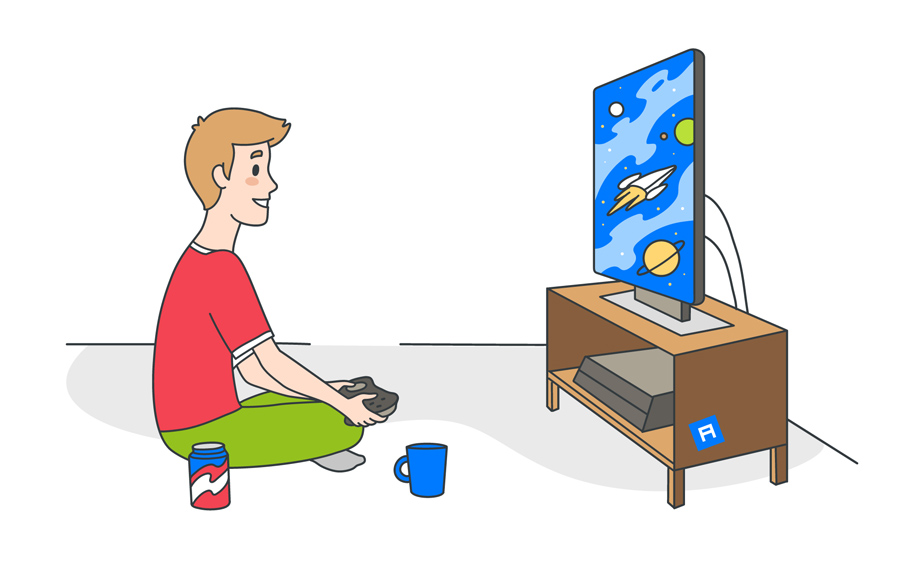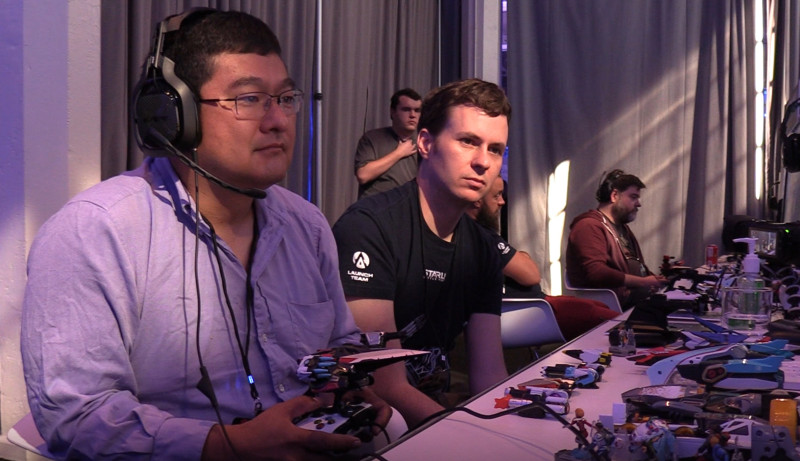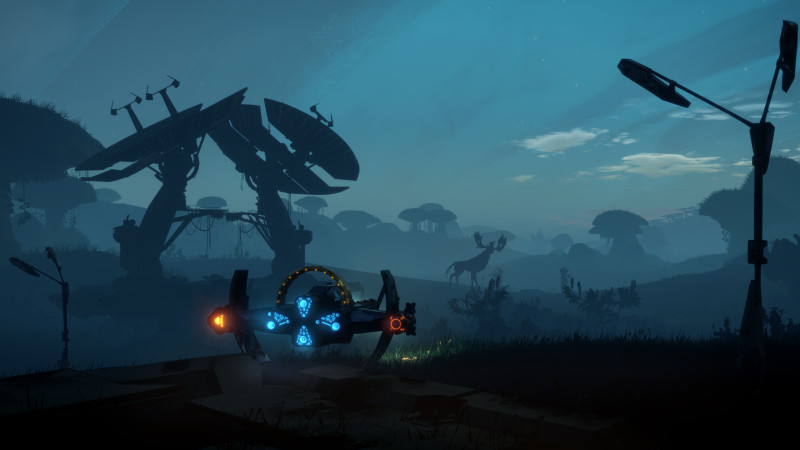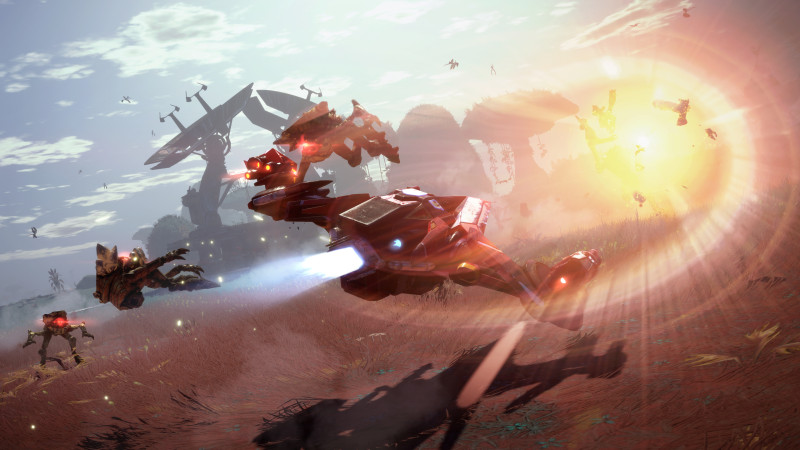How Ubisoft created its Starlink hybrid gaming kit: Battle for Atlas

The company Ubisoft lately declared itself in the market of toys-to-life, creating the game Starlink: Battle for Atlas . Perhaps this is just fine.
The pioneers in this market were the companies Activision and Toys for Bob, who jointly developed the Skylanders: Spyro's Adventure game in 2011. By 2014, this hybrid collection brought more than $ 2 billion in revenue from sales of video games and collectible toys - moreover, the latter were sold 175 million pieces.
')
But, this market is almost as rapidly collapsed. Disney and Warner Bros arrived in the segment, and then left it . In 2017, Activision was forced to suspend Skylanders . At about the same time, a small team at Ubisoft began to try their hand at combining toys with a video game. Their project turned out to be more popular at Ubisoft Toronto, and even Nintendo decided to support it, allowing Ubisoft to use the Nintendo character Starfox in its game.
While others were leaving the market, Ubisoft Toronto created the Starlink: Battle for Atlas game, where seven game worlds and a set of toys were developed. Choose a pilot, connect toys, spacecraft and weapons to the controller - and you are ready to start. You are free to do what you want, connect any characters and play on any of the seven planets created for this game.
I played on Xbox One, fighting on the planet Haven and connecting various toys to my controller, while producer Matthew Rose was telling me what to do. Then, Rose and I sat and talked face-to-face about the origins of Starlink and how Ubisoft wisely took advantage of the moment and occupied the vacuum in the toys-to-life market. He believes that the key to the success of the game lies in the freedom of action that Ubisoft gives users.
Let's see how things go with the game and toys when they debut on the PlayStation 4, Xbox One and Nintendo Switch on October 16.
Below is an edited transcript of the interview Matthew gave me.
Transferred to Alconost

Above: Matthew Rose, producer of the game Starlink: Battle for Atlas. Image courtesy: Dean Takahashi
GamesBeat: What originally inspired you to create Starlink?
Matt Rose: A couple of years ago, when we made the release of Splinter Cell: Blacklist, the first project launched by Ubisoft Toronto, the team began splits, and people began to go on other projects. Since then, the Toronto guys have worked on Far Cry, Watch Dogs and similar projects. I had the opportunity to assemble a small team, about eight people - and give something new. We had no idea what we were moving to, doing all sorts of experiments and prototyping, tried the craziest technologies and platforms.
One of the prototypes that hooked us was such a modular spaceship. At first it was just a handicraft prototype - a Wiimote controller, some consumer electronics, copper wires, components. But there was some kind of magic in this model, an instantaneous response that evoked excellent feelings, which allowed players to experiment and try to adapt to cope with the challenges. That's where it all started. Everything else developed later.
GamesBeat: At that time, Skylanders and other offers were already on the market, but do you feel that you were researching a niche that was not covered properly?
Rose: Yes, exactly. We learned a lot by watching our own children, learned to play with them. I have two children, five and seven years old, both of them addicted to video games. The more we started talking to our parents and children, the more amazing things were revealed to us. The current children are unique, in essence, this is the first generation that grew up in the families of gamer parents. They are drawn into video games from the first years of life. Well mastered with them and acquire a fair amount of skill. Very quickly, they grow to new challenges, and there are not so many proposals around that would serve as a worthy next challenge.
Too often, they jump from a completely childish game to something completely unrelated to the young user, and parents do not like the fact that the child plays such a thing. They simply cannot find a suitable alternative. That is what provoked us. The feedback we received - not only from children, but also from parents, from retailers, and from partners, was truly inspiring.

Above: Starlink creations are beautiful. Image courtesy: Ubisoft
GamesBeat: Here you mix a lot of different things. Where do you get them from?
Rose: Many of the key findings are from our childhood. In the 80s and early 90s, things were happening that really inspired us, and in many ways we pushed off from them. It was an era of rampant creativity in the production of toys, crazy breakthroughs and innovations followed each other, and these universes were created to support them. Saturday morning there were cartoons for which toys were made, and all this formed a harmonious world in which you were ready to get lost.
It was a large contact area. Moreover, the games on the space theme then also came and went in waves, but when I was small, it was one of my favorite genres. Then there were so many epic space scenes that I just drowned in them. These two sources of inspiration combined with each other gave rise to Starlink.
GamesBeat: What did you think when Star Fox appeared?
Rose: As I said, we were inspired by all those games from our childhood - and, of course, Star Fox occupied one of the central positions among them. I think it was the first 3D game I played on the console. We always dreamed: “would not it be cool if ...?” But then, after we presented the game at E3 in 2017, we were visited by a small group from Nintendo of America. They turned to us for a demo. We planned the game for Switch, so naturally we agreed. Their faces were almost impassive, but they could not hide their small smiles from us.

Above: Dean Takahashi from GamesBeat and Matthew Rose from Ubisoft play Starlink. Image courtesy: Ubisoft
After seeing the demo, they said: “Do you mind if we invite several colleagues?” Of course, it was just fine; so we met with the director of Mario Odyssey, the director of Mario Kart, all these legendary personalities from Nintendo. It was a wonderful, very instructive experience. And then, when the demo was over, and they said: “Can we visit you now with another group?” And then with one more ... and so on. Collaboration has expanded and expanded. Reggie Files-Aime and his team got involved. At that time, we already knew: something is brewing ...
After E3, we started negotiations with Nintendo. They were very inspiring, exciting. The climax of all this was an invitation to the Nintendo office in Kyoto, so I was privileged to go there with a couple of people from our team and offer cooperation. Not just Mr. Miyamoto, but the entire Star Fox development team. It was a stunning experience, a wonderful one. Everything went well. They liked the game itself and its user component.
For us, it was just such a case, about which they say: "the perfect couple." Star Fox fits naturally into Starlink IP. Therefore, we have tried well to achieve full integration of the product. It's not just a guest character. Characters are in interactive inserts. You can go through the whole game for Fox McClaud, and throughout the whole story there is a voice voice just like in the original. There are also exclusive missions and content, just on the Switch, Star Fox and other positive characters from the same universe participate in them.
GamesBeat: The toys-to-life market is huge. Quickly exceeded the bar a billion dollars a year. Then it simply collapsed, taking off from the HYIP cycle. One of the problems that, apparently, managed to detect, was the excessive amount of toys. It was simply not clear where to store them. I don’t know if you managed to figure out how to cope with it and create a durable project.
Rose: You can learn a lot. Here I see several aspects. Firstly, this niche started very strongly. Games on hardware, peripherals and objects have always been, and such things always develop in waves and cycles. I think a little stagnation happened in this niche. The niche flourished, because at a very early stage a number of great innovations were introduced into it, however, soon users began to feel monotony in it. It is on such things that we learned.

Above: Starlink: Battle for Atlas. Image courtesy of Ubisoft
One of the most important differences of our approach, which just helps to cope with accumulating toys - we offer more freedom in building the gameplay. You can organize it as fully digital. You can open to different players different entrances to the game. Thus, we can more flexibly approach to managing it, and still invite the game to the most different and different age users, whose interests are also different - and all of them will enjoy the game.
GamesBeat: As for toys - to a certain extent you have to guess which ones to do in advance.
Rose: Absolutely. You always want to be sure that you have as many toys as you need. One of our great achievements is that we have learned to work much more precisely with our audience; we were able to focus on a small line of highly integrated and high-quality proposals. At the time of launch, we offer a total of four different sets of ships. That is why we, as developers, manage to make each ship truly special and unique. At the same time, of course, from a business point of view, it becomes much easier to manage such sets of toys.
We acted, arguing as developers and businessmen, but we were also inspired by the positive feedback from the players. Remembering about childhood again, I imagine how you topple the box with the soldiers and feel that it is quite possible to assemble the entire collection. “I can put down these flags, I can build this. I know how to get here. ” When people feel that the game is simply an unimaginable number of elements, and all of them can never be reached, the rejection of such a game rhythm begins.

Above: Starlink: Battle for Atlas. Image courtesy: Ubisoft
GamesBeat: Apparently, your universe with these seven worlds turned out to be more interesting than others.
Rose: We have worked hard enough for our Atlas world to acquire a rich history, to be multi-level, full of secrets. This plot touches, he again talks about the classic battle between David and Goliath. There is a small team, the Starlink Initiative, which possesses a superpower: all its members can combine their strengths and acquire impressive power, so that they have something to counter the threat of the Forgotten Legion.
GamesBeat: You did not go through the full procedural cycle, right?
Rose: Some procedural technologies are used in our tools to help artists and designers create boundless worlds. But it was important for us to keep the content “made by hand”, where you can weave our historical layers, interesting moments and things to be discovered; really create such a narrative, where these layers can be removed one by one, learning about the Guardians and the era of the Electrum Fever. You start to believe in the reality of this place. It was important to us.
GamesBeat: It feels as if this world is living its own life.
Rose: Exactly. A toy is really a breakthrough thing, because it provides a link between the game and reality. But in this completely living world there is another big breakthrough that fascinates me: this world is modeled to the smallest detail, all the characters with AI are long-playing there, each of them constantly lives his own life. People are not immediately able to lay in my head how much it is different from the traditional game, because we have both failure and success with realistic consequences.

Above: Starlink: Battle for Atlas. Image courtesy: Ubisoft
If you land in a world, build a citadel there, build strong alliances, pump distant approaches, build fortification and protection, this world will be safe and able to defend. Your heroes will even be able to knock down bosses while you're out of the game. They can fight for you. Here is a living alliance. It inspires me, inspires precisely the thoughtful choice. This is interesting because children adapt to such things especially quickly. That is how things should be arranged in the real world. Many older players, experienced gamers, are already burdened with prejudices acquired in all other games, and they say: “Oh, this is interesting. I did not think that everything would be just that way. ”
GamesBeat: All these things that we managed to see - are they released at the same time, or do you stick to the release of some components?
Rose: Toys, collectibles? All that we have shown today - from the first wave of launch, the first release. We have four sets of ships, four teams of pilots, four versions of the arsenal - at different prices. Ship kits cost $ 24.99 each. Pilot teams are at $ 7.99, and arsenal options are at $ 9.99. But, of course, we have big plans for supporting the game in the future, we have plans for new releases of toys, and free content, new free features and missions, collections of content. We have not announced details yet, but we are going to continue building this universe and the Atlas star system.
GamesBeat: As for the story itself, how long can people play the game?
Rose: This living world is in many ways designed for a very long-term game. Of course, the struggle is not over. You can get carried away by the game. The Legion will continue to counterattack, and in the meantime you will strengthen your alliance. The game has epic final goals - for example, you can fully pump Equinox. In our opinion, the main campaign takes about 20-25 hours, depending on how distracted you are by other matters. But you can always return to this living world.
About the translator
The article is translated in Alconost.
Alconost is engaged in the localization of games , applications and websites in 70 languages. Language translators, linguistic testing, cloud platform with API, continuous localization, 24/7 project managers, any formats of string resources.
We also make advertising and training videos - for websites selling, image, advertising, training, teasers, expliners, trailers for Google Play and the App Store.
Read more
Source: https://habr.com/ru/post/421745/
All Articles